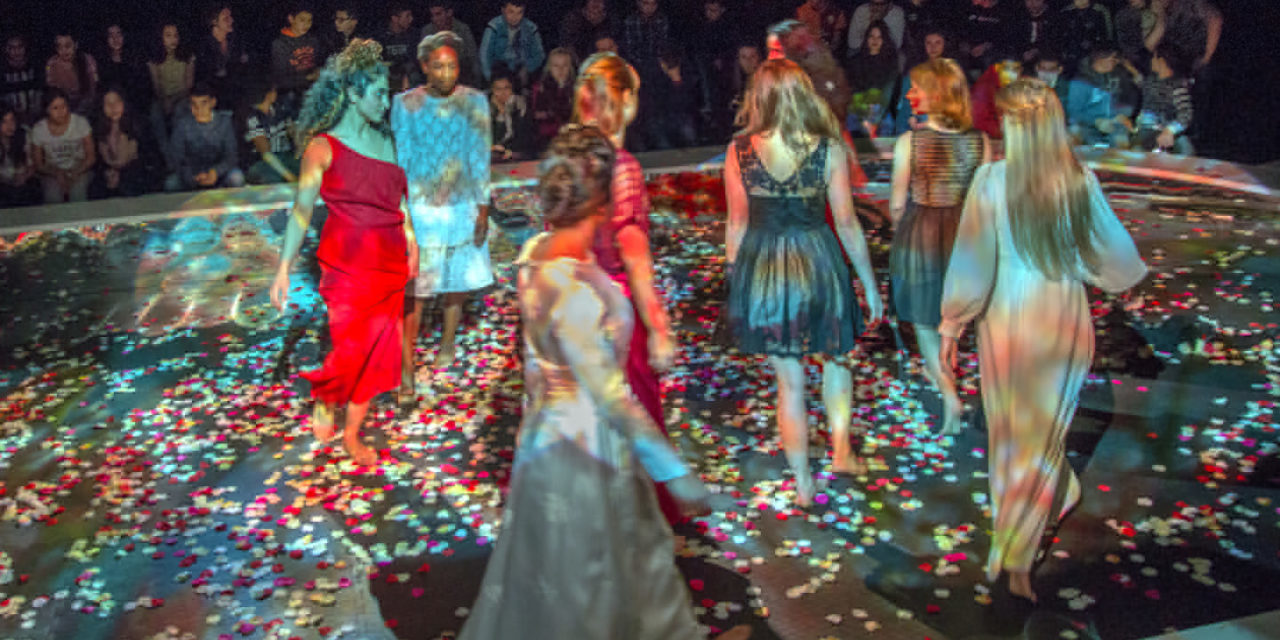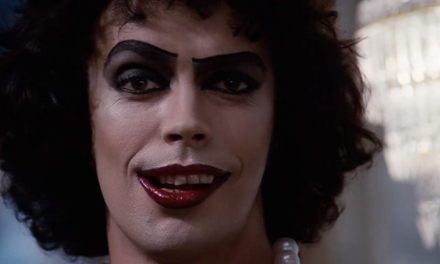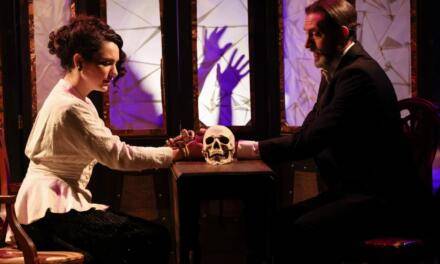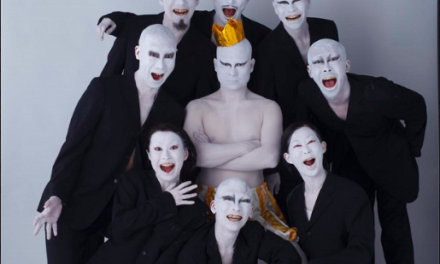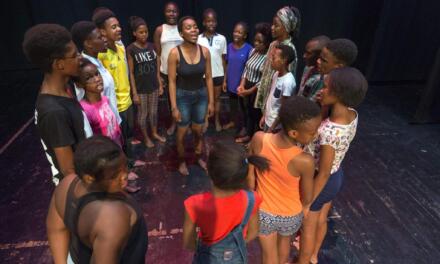The realization that our society is becoming superdiverse is more topical than ever. Even more relevant is the question as to how we want to deal with this fact. The reactions to the attacks in Paris in early January 2015 are telling: the Western world wavers between an us-them way of thinking in which repression has the upper hand, and a vision in which the attacks are seen as an extreme, fundamentalist act that has nothing to do with the otherness of large groups in society. That balancing act is laborious, and the sign of an age in transition and of an unsettled world. In the arts too, the hesitant handling of our superdiverse reality is striking. In youth theatre, there is in this regard a great opportunity. The presence of a young audience that finds superdiversity almost a matter of course compels youth theatres to be dynamic.
About a year ago I was immersed in a book by sociologist entitled Superdiversiteit: Hoe migratie onze samenleving verandert (Superdiversity: How Migration is Changing Our Society).[1] The author explains that in a growing number of cities, the majority of the population consists of so-called ethnic-cultural minorities, as a result of which there no longer exists a ‘majority’ to which ‘minorities’ would have to adapt, something that offers a great many opportunities for society as a whole. I was immersed in this book when my 5-year-old daughter told me about her day at school. She could not say whether one of the teachers was or was not wearing a veil. I can hardly imagine not being able to tell whether a female colleague is wearing a veil or not; it is a defining feature that it is impossible to overlook. For my daughter, however, a veil is what glasses are to us: they stand out if you pay attention to them, but often you do not see them because you are so used to them; it is no longer defining the way in which you divide people into groups.
So there I was then, with that book on superdiversity on my lap. That brief exchange with my daughter taught me more than all the books, articles and talks on this subject combined: today’s children – certainly those who grow up in multicultural cities and (school) environments – deal with diversity in a way that is a lot less inhibited than ours, which undoubtedly gives them a significant social head start. I thought back to my own time in primary school, 25 years ago, in a village where the only Moroccan boy in the whole school was everyone’s scapegoat, not least the teachers’. I thought back to my own development, in which I learned to see the presence of other cultural backgrounds as enriching, a path that I only ventured on when I moved to Brussels at age 17, and which I am probably still continuing along, as proven by the fact that I read books about diversity. I fully agree with Rachida Lamrabet when she paraphrases Martha Nussbaum:
A good society shows respect for a variety of outlooks and convictions, and ensures that people can develop, without drawing premature conclusions on the basis of preconceived notions and personal conceptions, without throwing up political or legal obstacles. It is the imagination that makes of the other a reality and that reveals to us a being, a human being with his own reality to let our empathic imagination work in matters of religious pluralism. Nussbaum says that our fear and aversion narrow our field of vision down to our own reality and that of a small circle of loved ones. We stay close to home with our imagination and we do not make the effort to relate to a life that is different or difficult. And yet that is precisely what is necessary, according to Nussbaum. By making our empathic imagination work, we acknowledge that the other has his own life and that, like ourselves, that person is entitled to the space needed to pursue his own goals on the basis of equality. But our imagination is lazy and that is why we make moral mistakes.[2]
I wrote in rekto:verso that youth arts often suffer from a Calimero complex[3]: they confirm themselves in an alleged inferiority. Youth arts are often permeated by the idea that they are artistically and otherwise subordinate to ‘real art,’ art for adults. Unjustly so: it is precisely because children often deal with today’s reality in a more supple manner that there is an occasion to see youth arts as a laboratory for the future. The audience of youth theatre is constantly renewing itself and growing up in a world that keeps changing. That offers opportunities to turn youth arts into a pioneer. During a round-table discussion on youth arts, Dutch theatre-maker Jetse Batelaan, now the artistic director of youth theatre company Artemis, put it as follows: ‘I found it quite pleasant to seek shelter in youth theatre in the midst of that vicious artistic climate that reigns in the Netherlands. I was convinced that I could do even more there than I could elsewhere, that I could go even further in pushing back borders, and that children would pursue that quest more easily.’[4]
That freedom to explore borders in youth theatre is certainly also present as regards superdiversity. Since children deal more easily than adults with the diversity that surrounds them, youth arts have an audience that in any case no longer expects diversity to be pigeonholed. That is also precisely how Bart Van Nuffelen conceived Dinska Bronska, his wonderful show at MartHa!tentatief. Dinska’s story, of a girl who flees to the West in search of a father that arrived here as a political refugee, may be extremely concrete, but the production itself offers the audience (8+) opportunities to project its own experiences in the story. The tactile way in which Anastassya Savitski dances the lead character presents unprecedented openness. Rather than burdening the spectator with conflicts and emotions, Dinska Bronksa is an invitation to reflect upon complex issues. It is indeed an extremely successful way of presenting themes such as diversity, cultural differences and migration to an audience that also has to deal with it itself, more or less directly.
Thinking progressively, acting conservatively
As a cultural worker – by which I mean both the theatre manager and the director, the festival programmer and the member of the evaluation committee – there are countless ways of not really having to relate to superdiversity. In the cultural sector, we use fig leaves to be able to keep doing what we do. One of the most tenacious fig leaves is the audience. Most people from another cultural background are, for instance, simply not interested in theatre, or so it is often said. It is not a part of their ‘culture’, we claim, often in a veiled way. Such a claim is problematic in several respects. Firstly, it is not true that people with a different cultural background are not interested in art or theatre. At most, they are not interested in the type of theatre that is on show in our theatres – something that also holds for a lot of people whose family tree is deeply rooted in Flemish soil. As a result you can ask yourself whether the lack of public interest from an ethnically-culturally diverse perspective has to do with that ethnic-cultural diversity or with the fact that our art market now simply appeals to a small group of people – and therefore whether the whole issue of diversity in the arts is not simply the consequence of a certain inability (or unwillingness) to make art that seeks a broad social basis.
A second persistent fig leaf is that there are no good theatre-makers and actors from a culturally diverse background. Quality is a subjective value that is defined by a limited group: what is good and what is not is not cast in stone. Yet we throw up our hands powerlessly, suggesting that people from a different background do not follow the right courses and as a result cannot play in professional productions: it is a circle that is hard to break out of. Moniek Merckx’s beautiful Voorjaarsoffer recently premiered at MAASTD in Rotterdam. This ritual performance features eight actresses who, drawing on Le sacre du printemps, sing about womanliness. In itself, the production has nothing to do with superdiversity. The diversity of the cast seems self-evident, and yet it is striking. But doesn’t the fact that the group of actresses reflects the same diversity as the commuters in Rotterdam Centraal train station do not say more about the theatre than about the production? Is the lack of diversity in theatre not due especially to a lack of brave decisions rather than a lack of so-called talent?
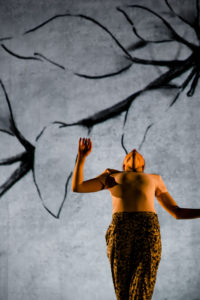
Dinska Bronska by Martha Tentatief / Bart Van Nuffelen. Premiere: October 2013. Photo credit Lot Doms
These are just two fig leaves, but they are tenacious. The use of fig leaves is human: we do it all the time, just read Kahneman on the subject.[5] We use specious arguments to take our car to the baker’s, to eat meat and to use Facebook – even though this is against our principles. And therefore also to do as though allowing diversity into our artistic practice is impossible or at least very difficult. Such fallacies may not constitute crimes, but this does not alter the fact that they can be shattered and that we therefore especially have to do that. For that is what is so peculiar: whoever talks to decision-makers in the art world rarely encounters people who say that they do not want diversity. On the contrary, most people in the art world strive after a tolerant and progressive society; they are open to the unknown and the other; they are in favor of equality and equal opportunities, and so on.
That progressive worldview jars with an artistic practice that in essence is very reticent and on occasion even conservative when it comes to diversity or ecology, for instance. Art history moves slowly; just think of the way in which Van Gogh, Picasso, and Duchamp were first received, so perhaps the acknowledgment of the power of cultural diversity in an artistic context will make it one day. Even that reasoning is also a fig leaf because we could learn from art history that we ourselves can take charge and can see diversity as something that is naturally a part of our cultural context. Not something to read books about, but something that really belongs to us. If we wish to take our cultural entrepreneurship seriously as a way of achieving objectives that we find important, then we should no longer interpret it in economic terms (audience participation, in-house revenue, sponsorship). We must seize the opportunity to put into action precisely those values that we really support – such as the creation of an artistic offer that is accessible to a superdiverse society, among others because it is made by a superdiverse artistic practice.
Face to face with a young audience
Het vertrek van de mier premiered in December 2014. Co-produced by Toneelhuis, kunstZ and HETPALEIS and directed by Guy Cassiers, it is based on the book of the same name by Toon Tellegen. The cast consisted of both professional and amateur actors, all from a different ethnic-cultural background. The play presented a reality check: it offers many possibilities to dream about how things can be even better – and it raises the question as to what our fig leaves are worth.
Let’s start with the first fig leaf: the audience. Overall, the audience for youth theatre is more diverse than in the adult circuit. But whoever takes a closer look at the figures will immediately see that this mostly has to do with the school plays: this gives a cross section of the youth population in the venue, and in a city like Antwerp it is very diverse. But it has to be said that this group does not flow through consistently to the family plays. Precise figures are not available, but in the ‘free plays’ the number of people from an ethnically-culturally diverse background is rather limited. This says a lot about the complexity and about the countless thresholds that people have to cross to get to the theatre and about the social codes they need to master to do so.
Youth theatre has been ‘gifted’ this diverse school audience and has the opportunity to take advantage of the varied composition. The fact alone that in all these school plays there is always a reflection of society – the children of parents from various nationalities, poor and rich children, the children of culture addicts and the children of parents who never engage with culture – is unique. In a conversation about Het vertrek van de mier, Cassiers points out what he himself describes as one of the great appeals of youth theatre: ‘Children are to a large extent unprejudiced: their world view is unfinished. That makes them very interesting spectators. Adults already know what they find good, beautiful and right, and in their experience of culture that is also what they often seek to have confirmed. Children are not yet capable of that. There is so much that they must still explore: a production is a way of discovering things. It often makes the impact of a production even greater. It is also striking how quickly they deal with this. When Yves-Marina Gnahoua enters the stage in Het vertrek van de mier and starts talking, there are initially a lot of reactions. Some children laugh or make a comment because her Dutch sounds quite strange. But when she enters a second time, the children are already used to her way of talking. The step that is taken there is of great importance. Because children come into contact with difference so early, they deal with it better.’ Adults, by contrast, have a code of politeness and will not react out loud if someone sounds strange. But afterwards they are the ones that will criticize the use of language and its intelligibility in Het vertrek van de mier.
The young audience behaves in other words like a centipedal interpretation machine rather than as a tub full of preconceived judgements: their assessment is often unusually clear and hard, but not formed in advance. The more diverse the audience, the more diversified the interpretation machine will be, the more visions there will be on a play. The trick for the youth theatre-maker consists in respecting that interpretation machine for what it is worth, in listening to it instead of, as adults like to do, quickly judging it and then condemning it.
The second fig leaf: there are not enough makers, actors and so forth from an ethnically-culturally diverse background. The training courses deliver up few people fitting that profile so we cannot hire them. In an earlier text, I brought up the idea of a quota.[6] That the sector reacted rather coolly to the suggestion is understandable, but still, at some point, initiatives have to be taken to reverse the situation. Because the child of Moroccan parents who has never seen an actor of Moroccan origin on stage will probably not soon be inclined to go to the theatre himself for the simple reason that he can hardly identify with it. ‘For me positive discrimination is not a bad idea’, says Cassiers. “In the Netherlands they started doing this quite early already. The results are tangible. Don’t underestimate what it means for a child to suddenly see someone ‘like him’ on stage, or to all of a sudden hear Russian being sung on stage. These are enormous triggers for a child if it experiences them at the right moment.”
It is easy to point the finger at the schools. But the lack of diversity in the sector has all the characteristics of a circle and that is something you can break out of at various places. There is absolutely no logic in the thought that this sort of change must start in the schools. There are even advantages to the idea of letting the sector itself break the circle and, in combination with this, to assess a number of established practices: “The work method was very different,” Cassiers concurred in our conversation about Het vertrek van de mier.
“I employed a more open structure than I am used to. With someone like Katelijne Damen I know exactly where she stands and how I can challenge her. The situation was entirely different with this cast. I approached it as a journey of discovery: I did not know beforehand where it would lead, and I was also able to open myself up to what the players themselves contributed. The less experience actors have, the more I can start out from who they are, from their own life experiences, from that which makes them unique.”
On doubts and idealism
Superdiversity in the performing arts – as in society – is a controversial issue. No matter how much we wish to embrace diversity as something that can offer added value, the concept always makes us end up in a tub full of doubts and uncertainties. But sometimes you have to make the leap, even if you need to block your ears, eyes, and nose. Youth theatre is a biotope in which that is possible. Not because it takes place in the shelter of the ‘real’ performing arts: on the contrary, because youth theatre is made for an audience that stands in the world in a more direct manner, freer of prejudice, more prepared for adaptations to reality. They are the future. In the hand of a child, our arguments and doubts are often unmasked as fig leaves. Our doubts are not insincere, but they stand in the way of our idealism. Doubts and idealism: we must also dare to continue thinking about that balance.
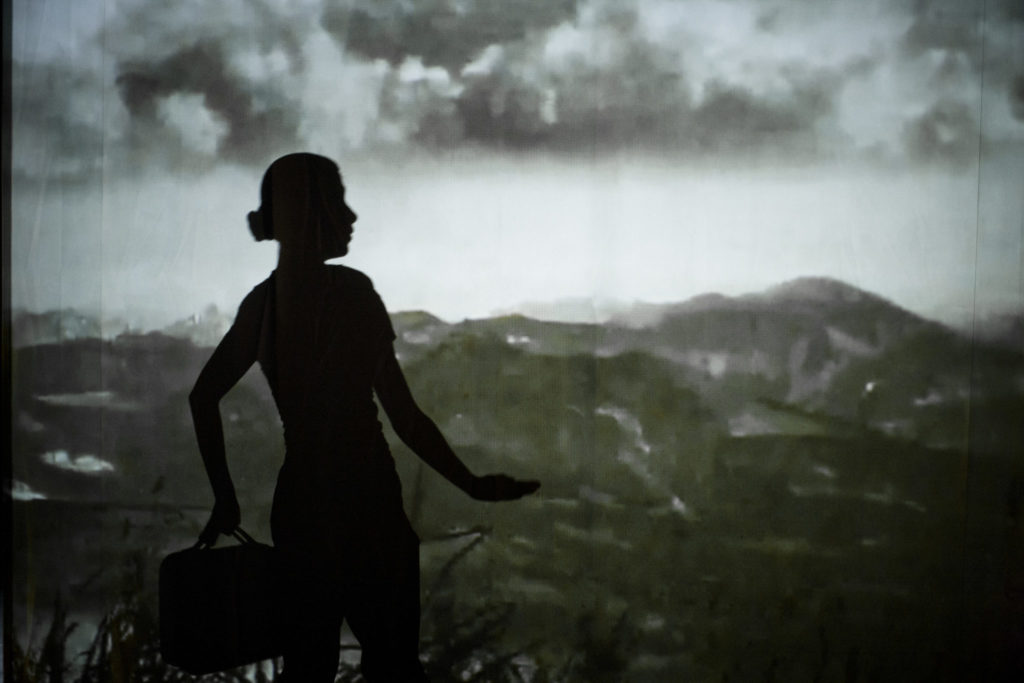
Dinska Bronska by Martha Tentatief / Bart Van Nuffelen. Premiere: October 2013. Photo credit Lot Doms
Tom Rummens writes for various media. Until September 2013 he was the performing-arts programmer at the Brakke Grond. He now coordinates the international operations of HETPALEIS.
Published with the kind permission of Etcetera
Notes:
[1] Dirk Geldof, Superdiversiteit: Hoe migratie onze samenleving verandert, Leuven, The Hague, Acco, 2013.
[2] Rachida Lamrabet, ‘We zijn allemaal verschillend. U ook?’, in: Mo* Paper #87, 2014.
[3] Tom Rummens, ‘Hoe Calimero een kanarie werd’, in: rekto:verso #63, October 2014.
[4] Conversation at de Krakeling in Amsterdam, 7 January 2014.
[5] Daniel Kahneman, Ons feilbare denken: Thinking, fast and slow, Amsterdam, Antwerp, Contact, 2011
[6] Tom Rummens, ‘Tien voorstellen voor de podiumkunsten – Voorstel 4: een model voor progressief ondernemerschap’, op: www.rektoverso.be, 2014.
This post was written by the author in their personal capacity.The opinions expressed in this article are the author’s own and do not reflect the view of The Theatre Times, their staff or collaborators.
This post was written by Tom Rummens.
The views expressed here belong to the author and do not necessarily reflect our views and opinions.

